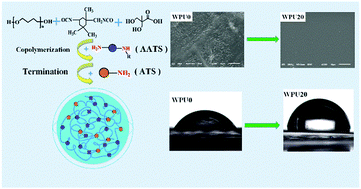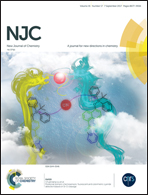Synthesis and investigation of well-defined silane terminated and segmented waterborne hybrid polyurethanes
Abstract
Environmentally friendly waterborne polyurethanes (WPUs) are copolymerized with (3-(2-aminoethyl)aminopropyl)triethoxysilane (AATS) and terminated with 3-aminopropyltriethoxysilane (ATS). The ATS content was kept constant and the effects of AATS on the structures and properties were investigated in terms of crystallinity, thermal stability, mechanical properties, dynamic thermo-mechanical properties and surface behavior. Fourier transform infrared spectroscopy (FT-IR) analysis confirmed the existence of a hydrogen bonding interaction at the interface between the polyurethane and siloxane moieties. As the AATS content increased, the crystallinity decreased slightly as revealed using wide angle X-ray diffraction (XRD), the surface of the waterborne polyurethanes became much smoother as observed through a scanning electron microscope (SEM), the Si element content on the surface was enriched as confirmed using X-ray photoelectron spectroscopy (XPS), and the microphase separation was enhanced as shown using dynamic thermomechanical analysis (DMA). The incorporation of AATS led to an increase in hydrophobicity, tensile strength, Young’s modulus, as well as thermal stability but a decrease in the elongation at break of the WPU films.



 Please wait while we load your content...
Please wait while we load your content...